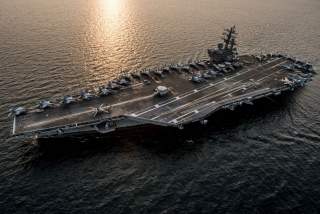12 Carriers and 350 Ships: A Strategic Path Forward from President Elect Donald Trump
President Elect Donald Trump, correctly understanding the current strategic environment, is committed to building a 350 ship Navy.
A 350 ship Navy will not solve all of the nation’s problems. Years of neglect and whimsical foreign policy pronouncements of false red lines and “leading from behind” will have to be overcome, but 350 ships will allow the nation to begin protecting its interests in the 18 maritime regions of the world on a consistent and credible basis. The Navy needn’t look exactly like it did the last time it had 350 ships, we have far more destroyers today than we did in the 1990s for instance, and they are far more lethal than their predecessors, so perhaps we can have fewer cruisers than we had in the past. Frigates, smaller, cheaper and of a more lethal design than the current Littoral Combat Ship, something more analogous to those built by our European allies perhaps, should be bought in large numbers to provide increased naval presence patrols. Presence, the importance of being there, often with very basic, low-end ships that are backed up by the threat of high-end ships, is often enough to uphold American interests. Lastly, the nation needs more fast attack submarines and more guided missile submarines. Today we have just shy of 60 of these quiet, stealthy platforms, but this number will fall far into the 40s during the 2020s before beginning to rise again in the 2030s. In the end we will need more than 70 of these boats to protect our interests.
All of these recommendations assume that the industrial base is in a position to support a buildup in the Navy. Years of decline during the Clinton, Bush and Obama administrations have wreaked havoc on the shipbuilding sector. Companies have downsized, laid off, or retired skilled workers or merged with other companies to remain afloat in troubled times. Going from building two Virginia Class submarines per year to four would not be as simple as adding more money to the ship construction account. Welders certified to work on nuclear powered vessels take a year or more to train and certify, and the companies involved cannot cut corners for fear of damaging their reputations and stock prices. Nor can companies plan long term production ramp ups unless the Congress gets strongly behind President Elect Trump’s vision and commits the nation to a long term, multi-year, block-buy naval building program that includes both ships and aircraft.
Twelve carriers, 350 ships, and a longer ranged carrier air wing should be the basis for the United States’ grand strategy going forward. We are a maritime nation. We have always been a maritime nation since our founding, and now there is a commitment to make the investments needed to execute a new maritime based national security strategy. This will be a national effort from the start, an effort that will rebuild Blue Collar jobs throughout the nation in support of our national defense, and while there will surely be challenges to come; there is at least a vision and a number (350) and a beginning on January 20, 2017.
Dr. Jerry Hendrix is a Senior Fellow and Program Director of the Defense Strategies and Assessments Program at the Center for a New American Security. A retired Captain of the United States Navy, Hendrix previously served as the Director of Naval History and Military Assistant to the Director of the Office of Net Assessment.
Image: US Navy

